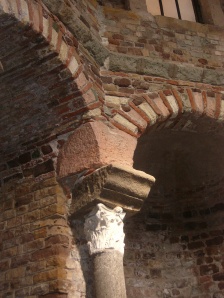Wherever the Romans built a settlement it was inevitable that when the empire crumbled those constructions became a ready source of material for early Christian buildings. This happened in Ventimiglia. Massive stone blocks and columns were hauled a good two kilometres away from Albintimilium (the Roman settlement in the east of what was to become Ventimiglia) across the river and up the hill to be used in the building of present day Ventimiglia Alta. The same occurred in Frejus. Here, recycling building materials from the Roman arena and theatre was certainly much easier than in Ventimiglia as the terrain is quite flat. There was no river to cross or hill to conquer in order to construct the town’s 5th century baptistery and its first cathedral. As in Ventimiglia, Frejus’s baptistery is octagonal, although unlike Ventimiglia’s, it sits on a square base.
Ventimiglia Alta’s octagonal baptistery on the left and the one at Fréjus on the right next to the Cathedral.
Outside and in the baptistery and adjoining cathedral and cloister glow with warmth as they are constructed in deep red volcanic stone from the Massif de l’Esterel – one of the oldest land masses in Europe.
In early Christian times, baptisms were by full immersion. The unbaptized person entered the baptistery from outside through a small, low doorway. They undressed and entered the font, protected from view by a curtain which hung from pillars around the font. After the baptism they entered the cathedral directly through a much wider and taller door. The wrought iron door that we use today is a recent opening. The full immersion font, which was originally lined with marble, is no longer used.
While the baptistery has remained almost entirely as it was when it was built in the 5th century, the Saint Léonce Cathedral has undergone numerous changes. Very little remains of the original construction: most of what we can see today dates from when the town was rebuilt between the 11th and 14th centuries after it had been destroyed Saracen pirates. The cathedral is in fact made up of two churches: the original Notre Dame cathedral and the adjoining Saint Etienne parish church: these were made into one in the 13th century.
I was intrigued by this statue standing quite high up in a corner of the cathedral: it’s the first time I’ve seen a female saint with a broom and a demon. In fact there’s something of a contradiction between the domesticity of the broom and her warrior-like domination of the demon. Correct me if I’m wrong, but it seems from my book of saints and their attributes that this must be Saint Martha of Bethany. She’s the one who was a close friend of Jesus’s: he rebuked her for doing housework while he preached. And the demon must be the man-eating Tarasque – it supposedly lived in the woods along the banks of the Rhone between Arles and Avignon, so not all that far from Frejus. Martha is said to have come to Provence to preach and to have tamed the Tarasque by sprinkling it with holy water.
The cloister and a reproduction of one of the strange paintings in the wooden ceiling
Unlike a convent or monastery cloister which was usually for the exclusive use of the nuns and monks, Frejus’s bishops opened the cathedral cloister to the public as a place for meeting and contemplation, and apparently as a way of showing off their wealth! In the 1300s an upper gallery was added around the cloister. The ceiling of the main gallery was covered with 1,200 larch wood panels painted variously with pictures of religious figures, scenes from everyday life and a fantastic range of bizarre creatures such as beasts that are part man, part animal; or part animal, part bird. There is no real explanation for these strange drawings and sadly only 300 of them remain.
Six of the original ceiling panels

A shop near the cathedral – they may well have head aches even if the lintel is resting on cushions!









